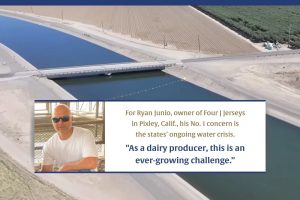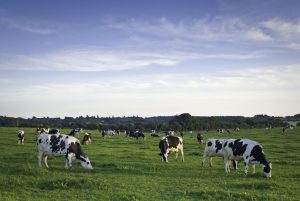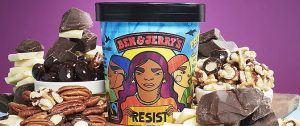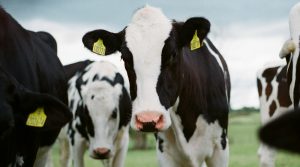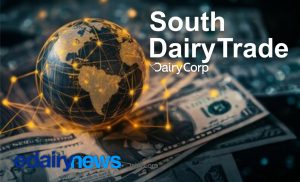
Sporting a classic pair of overalls, Donaldson nuzzled some cows, cracked some jokes and challenged his 57.4 million followers to be sustainable with their daily lives. But this video is more than funny content; it’s sponsored, tagged #UndeniablyDairy.
If you don’t know who “MrBeast” is, your kids almost certainly do. He’s massive with the Gen Z demographic, consistently trending on TikTok and YouTube, most famous for eye-grabbing philanthropic stunts or Squid Game recreations, sometimes reaching over a billion views a month. He’s also the latest influencer to collaborate with Undeniably Dairy, a massive, multiyear, marketing campaign designed to boost sagging sales of milk worldwide.
But this campaign isn’t a ‘how do you do fellow kids’ cringey faux pax. These videos are popular, cool even: Iced coffee hacks. Cooking videos. Overly complicated debates of how to butter bread. The videos have already reached hundreds of millions of users and show no signs of stopping.
They tap into trends and challenges. In one, the Watt brothers of the NFL drink milk to overcome a hot wings challenge. In another, an influencer named Matt Peterson takes on a challenge of only eating dairy for an entire day (the title is misleading as he frequently only has a dash of dairy in his meals, including a particularly-lazily made burrito with one mere slice of Gouda). In fact, the massively-viral ‘butter board’ trend originated from a chef account that has collaborated with Undeniably Dairy seven times, though it’s not clear if it’s a direct part of the campaign’s sponsorship.
Others tap into the specific mentality of students, claiming dairy can help “get your life together” before class or arguing that dairy can “reset” yourself after studying for high school tests, or energize you to stay up all night gaming. Still, other videos emulate a fever dream, a clear attempt to break into the zeitgeist that makes up the wacky, surreal humor of Gen Z.
The dairy industry (or their social media firm) is clearly tapping into something. But these TikToks paint a picture that doesn’t reflect reality.
The Facts Behind the Claims
The claims of the campaign are diverse but tend to fall along three main categories: sustainability, health and ethics. Each of them approaches branding differently.
Undeniably Dairy greenwashes milk products as sustainable by cherry picking data points. For example, MrBeast claims that dairy products are made with 20 percent fewer emissions from 15 years ago (a technically correct fact by some measures), but follows this with “dairy is made with care for the planet.” That last bit is part of a huge push from the animal agriculture lobby to pivot towards a sustainable brand image.
The scientific community is in consensus that the dairy industry is one of the biggest culprits behind the current climate crisis. We’ve all likely heard of ‘cow burps’, which are massive sources of methane emissions. Dairy production also uses more land than alternatives, which drives deforestation and, therefore, increased climate pollution. But the problems go beyond climate emissions. Due to the inefficiency of animal agriculture, specifically ruminant animals like cows, factory farms are destroying biodiversity across the globe by contributing to deforestation. Factory farms also contribute to polluted water reservoirs and air quality.
Many health claims also lack context. While dairy provides nutrients (as does fortified soy and other plant-based milks), the protein and calcium advantages of dairy come with drawbacks. Milk’s claim that it is good for bones isn’t some unassailable truth: the evidence on milk intake and bone strength is conflicting, for example.
But the largest misleading statements touch on how cows are treated on dairy farms. The dairy industry has always gone to great lengths to suggest its cows are content. Many brands of milks and cheeses are infused with happy imagery of dancing cows or literal brand names like “The Laughing Cow”. Now this strategy has a new life.
TikTok is a perfect platform to disseminate misleadingly positive information about an industry. Each video is bite-size, often textually incapable of nuance, with a single centralized message. The For You page (TikTok’s closest approximation of a homepage) can create a fabricated image that, while true, doesn’t accurately reflect the state of the world more broadly. As data expert Kalev Leetaru put it succinctly, there exists “a lack of connection between social reality and physical reality.”
The Undeniably Dairy TikTok campaign uses this feature to its advantage. Sentient Media reviewed the top 50 #undeniablydairy TikToks that featured cows. Of them, 90 percent featured words or branding consistent with small family farms, including green pastures, family members working the fields, cows roaming free or friendly voiceovers from farmhands. This messaging implicitly suggests that the milk you’re likely to buy in a supermarket comes from a small, humane farm.
But social media videos are not representative of reality. According to USDA figures, only 1/5 of dairy farms are small farms with less than 200 cows. The vast majority of cows live their entire lives on factory farms, some packed with hundreds of thousands of animals that spend most of their time on concrete rather than pasture, suggests reporting from The New York Times.
Yet small farms are not necessarily better. All commercial dairy farms require the female cows to be artificially inseminated and, when they finally give birth, have their baby calf taken away from her (often to be killed or, worse, to become veal). Even cows on “wholesome” farms, the ones paraded on TikTok and dubbed with silly voices, are almost always put down at a young age when they cease being profitable.
A review of the scientific literature from 2017 documented that cows are intelligent, social, and capable of making friends — a fact that makes the dairy industry treatment especially cruel.
A New Form of Marketing
TikTok might be a new marketing avenue for the dairy industry, but the strategy of targeting children is nothing new. Since the 1980s, the dairy industry has consistently gone after schools as one of its biggest audiences, especially with its infamous “Got Milk?” campaign. Seemingly everyone, from Taylor Swift to Kermit the Frog, sported a white milk mustache or boasted a sugary chocolate milk campaign.
Despite these decades of efforts, milk drinking in the U.S. has been on a steady decline, though yogurt and cheese have made up for it some years. Plant-based milks like almond, soy and oat, on the other hand, have seen 23 percent market increases from 2015 to 2019. The plant-based milk industry is expected to reach 123 billion by the end of this decade.
The dairy lobby has been working overtime to thwart plant-based industry progress. In 2018, dairy companies launched the “Februdairy” campaign (a rebuke to ‘Veganuary’) in order to boost sagging milk sales and push back against sustainability and animal cruelty critics. Bringing Undeniably Dairy to TikTok is their latest attempt to push the industry’s message.
So far, the Strategy Is Working
Even though plant-based milk sales show no signs of slowing, there are signs that the Undeniably Dairy campaign is reaching its intended audiences.
According to Edelman, an advertising firm that collaborates with the Undeniably Dairy campaign, they’ve achieved 72 million total video views. By the marketing firm’s metrics at least, the campaign was a success. It’s unclear how the firm measured these shifts but Edelman claims their target audience is now 6 percent less likely to be interested in plant-based alternatives to dairy, 25 percent more likely to believe that dairy cows are treated humanely, and 14 percent more likely to believe that dairy farmers take care of the environment.
In terms of actual sales, the picture isn’t clear yet. But the dairy lobby reported a slight annual increase this August. Some forecasters suggest the industry may make modest gains in the next two years.
The real money maker for U.S. dairy is in exports. Globally, dairy consumption is climbing. The American dairy industry is eager to put milk in the hands of untapped markets, especially in the East. China, despite being the world’s second-largest economy, is historically low in dairy consumption.
At the 2021 Dairy Congress, industry professionals described China and Southeast Asia as having “huge potential for further growth,” specifically highlighting sugary products with packaging designed to be easily held by children.
So far, it’s working. Imported dairy is on the rise in China. The prospects for continued growth are strong, and TikTok just might be the perfect tool. TikTok, whose parent company, ByteDance, was founded in China, will surpass 835 million users within a few years.
The Undeniably Dairy campaign is already building virtual inroads, with videos of Vietnamese yogurts, Korean influencers, Taiwanese street foods and boba cheese tea.
A Campaign for the Modern Era
Clever advertising is nothing new for the dairy industry. What’s different about this campaign is that it feels less like a campaign than previous attempts, and that could make it more successful.
While TikTok advertisers like Undeniably Dairy are required to be transparent about sponsorships, this campaign is purposefully less obvious than “Got Milk” was. There is no central slogan. There is no one specific target audience (videos are just as likely #trump2020 as they are #ramadan) The messaging and tone of the campaign is as varied as possible. Dairy is throwing milk at the wall and seeing what sticks.
The dairy industry benefits when consumers don’t investigate the impact behind their products. The average TikTok user may not even be aware that they are witnessing a coordinated social media campaign every time they open their “For You” page and see silly videos of milk chugging, cows lip-syncing to meme songs or #relatable content. And that’s by design.




